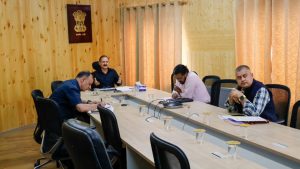The Advisor of UT Ladakh, Dr Pawan Kotwal chairs the meeting of the 3rd State Broadband Committee.

Leh, March 10: The 3rd State Broadband Committee (SBC) of the Union Territory of Ladakh was held under the chairmanship of Advisor to Hon’ble Lieutenant Governor, UT Ladakh, Dr. Pawan Kotwal, and discussed mainly the Centrally sponsored schemes and their roadblocks along with the concerned stakeholders at the Civil Secretariat, Leh.
Advisor Kotwal was apprised regarding the several agendas which include a review of the 2nd SBC meeting minutes/ decisions; state row portal issues, electricity supply, USOF 4G saturation Project; USOF 354 uncovered villages project; 5G implementation plan; call before u dig (CBuD) App; Digital Communication Readiness Index (DDRI), etc
Advisor Kotwal addressed that the telecom network is the backbone on which other sectors ride, therefore he exhorted that non-provision of telecom connectivity to villages is the most pressing issue in Ladakh. Highlighting the difficulties faced by the public especially the students, in far-flung areas he urged the telecom operators to make internet connectivity a top priority in unreached areas. He asked them to appoint dedicated officers on the ground to address the grievances of the people.
Two projects were discussed exhaustively, where officers and concerned stakeholders discussed that to develop telecom infrastructure there are many indicators in order to ensure complete coverage of villages 62 project sites covering 354 villages have been sanctioned by DoT of which 57 are ready under the 4G Saturation project. The Advisor directed the implementing agency (Reliance) to push the telecom drivers to complete it before October 15. Whereas in the other Project i.e., the 5G implementation Plan, where DOT requested the state administration to do road street furniture mapping on the Gati Shakti portal and use the assets of the other department in 5G proliferation which will help TSP in installing the 5G Proliferation.
The meeting was attended by the Secretaries, concerned officers, and stakeholders


